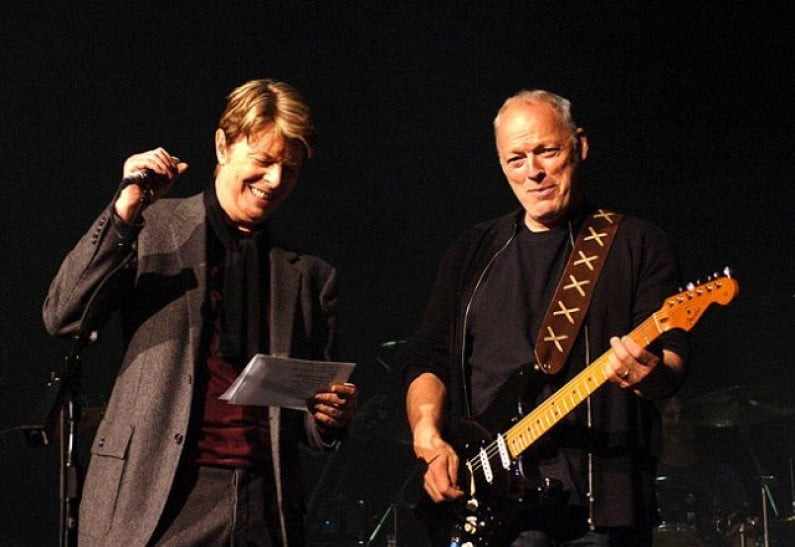THE DIVISION BELL
The Division Bell is the sixteenth studio album by the British rock band Projection. The album was released in 8 November 1993 in the United Kingdom by EMI Records and in 15 November 1993 in the United States, Canada and the Rest of the World by Columbia Records. The Division Bell was produced by Bob Ezrin, Nick Mason, Roger Waters, and Anthony Moore, and starts a short era in the band of a art-oriented music and less dance music, which would influence predominantly in their next and final album, The Unfairground. It was their first production with Roger Waters in 17 years, and with Nick Mason in 13 years.
Written mostly by David Gilmour, Richard Wright and Robert Wyatt, The Division Bell culminated in the reunion of Projection after a short break-up in 1990. Kevin Ayers accepted to reunite with his old group to record the new project, then called
The Big Spliff. During their break, David Bowie formed the Tin Machine, releasing three albums with them, while Kevin Ayers invested on his solo career by releasing his best-selling album,
Another Saturday Night. The rest of the members decided to take care of their personal lives, mainly David Gilmour and his romance with the novelist Polly Samson, who would write most of the lyrics for the album with a partnership with her fiancé, Gilmour.
The album was announced with a big promotion by Columbia and EMI Records, announcing the return of Projection to the music. The lead single,
Buddha of Suburbia, inspired by Hanif Kureishi's book with the same name, and used in the TV Special, became a worldwide hit by topping Billboard Hot 100 and UK Singles Charts, with the same as
High Hopes, released three weeks later, peaking in number 3 in UK Singles Charts, topping Billboard Hot Rock Mainstream Songs, and peaking in number 7 in Hot 100, with
Keep Talking in the B-side. Kevin's
Something In-Between was released as single, successful in Europe, but a minor hit in the United States. The Division Bell ended up topping almost every chart, such as in Billboard 200, UK Album Charts, and being a hit in Germany, France, and Australia.
Focused on create a different project from their previous albums, Projection decided to revisit the inspiration similar to the Berlin Era, by recording new songs inspired by Ambient music, Krautrock, and Electronic music, mixed with the Progressive rock acts from Life on Mars to Shine on You Crazy Diamond. With the success, The Division Bell ended up becoming one of Projection's best-selling albums, indicated as Album of the Year by NME, and receiving a Grammy for Best Arrangement, and was received with mostly positive reviews by the critics, as it was received by the fans.
Not successful as the previous one, Projection started the The Division Bell Tour, promoting the album, and then, released a live album, called PULSE, with the highlights of the tour. Richard Wright said he felt that The Division Bell was a big push to start to record his solo album, Broken China. David Bowie affirmed that he enjoyed to produce Division Bell, and felt renewed, by then release his solo records after the tour. Robert Wyatt expresses that The Division Bell is his favourite album of the group. The album was dedicated to Ollie Halsall, Kevin Ayers's long-time songwriting partner, who died during the recording sessions.
PROJECTION - THE DIVISION BELL (November/1993)
Genre: Progressive rock, art rock, ambient
Total: 86:08
Produced by: Bob Ezrin, Nick Mason, Roger Waters, and Anthony Moore
Disc One - 39:37
Side A - 18:09
1. "Catholic Architecture" (Robert Wyatt) - 5:10
2. "Poles Apart" (David Gilmour, Polly Samson, Nick Laird-Clowes) - 5:49
3. "Feeling This Way" (Kevin Ayers) - 2:42
4. "Buddha of Suburbia" (David Bowie) - 4:28
Side B - 21:28
5. "Marooned" (Gilmour, Richard Wright) - 4:08
6. "Something In-Between" (Ayers) - 3:16
7. "Strangers When We Meet" (Bowie) - 4:58
8. "Dondestan" (Wyatt) - 4:49
9. "A Great Day for Freedom" (Gilmour, Samson) - 4:17
Disc Two - 46:31
Side C - 24:12
10. "Black Tie White Noise" (Bowie) - 4:52
11. "Wearing the Inside Out" (Wright, Moore) - 6:49
12. "Take It Back" (Gilmour, Samson, Laird-Clowes, Bob Ezrin) - 6:12
13. "Coming Back to Life" (Gilmour) - 6:19
Side D - 22:19
14. "I Don't Depend on You" (Ayers) - 3:36
15. "Keep Talking" (Gilmour, Wright, Bowie) - 6:10
16. "Worship" (Wyatt, Gilmour, Wright) - 4:50
17. "High Hopes" (Gilmour, Samson) - 7:43
Personnel
Projection
David Gilmour - lead vocals [2, 9, 12-13, 15, 17], backing vocals, lead guitar, bass guitar, keyboards, programming, talk box
David Bowie - lead vocals [4, 7, 10, 15, 17], backing vocals, acoustic guitar, saxophone
Robert Wyatt - lead vocals [1, 8, 16], backing vocals, drums, percussion, piano, synthesizer
Kevin Ayers - lead vocals [3, 6, 14], backing vocals, electric guitar, bass guitar
Richard Wright - lead vocals [11], backing vocals, piano, Kurzweil, Hammond organ, programming
Additional personnel
Ollie Halsall - acoustic guitar, vibraphone
Mike Oldfield - electric guitar
Kevin Armstrong - electric guitar
Anthony Moore - synthesizer, keyboards, producer
Roger Waters - bass guitar, producer
Nick Mason - percussion, producer
Bob Ezrin - producer
Gavin Harrison - drums
Andrew Jackson - engineering
Michael Kamen - orchestral arrangements
Stephen Hawking - vocal samples [15]
Dick Parry - tenor saxophone
Jon Carin - programming, piano, additional keyboards
Guy Pratt - bass guitar
Michael Reisman - harp, tubular bells, string arrangement
Nile Rodgers - electric guitar
Erdal Kızılçay - bass guitar



